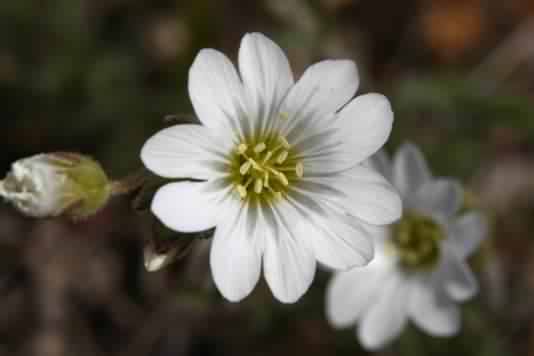
Photo ©2009 Wsiegmund
Click photo for a larger image
Field Chickweed - Cerastium arvense
Family - Caryophyllaceae (Pinks)
Also known as - Field Mouse Ear

Photo ©2009 Wsiegmund
Click photo for a larger image
Field Mouse Ear is another plant found in Brickfields Park from the Caryophyllaceae (Pink) family. A widespread species occurring throughout Europe and North America and parts of South America. It is found in banks and waysides, grassland, roadsides, wasteland, usually on calcareous or slightly acid sandy soils, throughout Britain. Grows to 20–45cm (8–17in), small white flowers 2cm (0.8in) across composed of five white petals 7.5–9m (0.3–0.35in) long, deeply bilobate with round tips. At the centre of the flower are ten male stamens with yellow anthers on slender stalks. There are five female styles. The flowers are which appear April to August are hermaphroditic, usually pollinated by small flying insects (Flies, bees Etc), seeds maturing May to September.
The fruit is a capsule up to 1.5cm (0.6in) long with ten tiny teeth at the tip containing several brown seeds. Prefers well drained soils of most types (sandy through to clay), sunny position, drought tolerant. A vary variable species it can grow as a clump, as large mats or smaller upright plants, growing from a taproot or tangled system of rhizomes. The plant is hairy in nature, often with glandular hairs, leaves are linear, lance–shaped or oblong. Botanical description for Arvense.
FBCP do not advise or recommend that Field Chickweed – Cerastium arvense is eaten or used as an herbal remedy. Medically the plant has been used as an astringent and also in the treatment of injuries and miscarriage. A decoction of Field Mouse Ear is said to stop uterine bleeding.
Site design ©1999– Brickfields Country Park - Privacy -